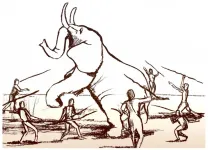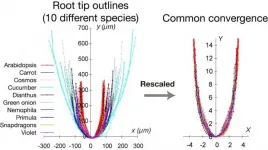The human brain grew as a result of the extinction of large animals
Researchers from Tel Aviv University propose a new explanation for human evolution:
2021-03-01
(Press-News.org) A new paper by Dr. Miki Ben-Dor and Prof. Ran Barkai from the Jacob M. Alkow Department of Archaeology at Tel Aviv University proposes an original unifying explanation for the physiological, behavioral and cultural evolution of the human species, from its first appearance about two million years ago, to the agricultural revolution (around 10,000 BCE). According to the paper, humans developed as hunters of large animals, causing their ultimate extinction. As they adapted to hunting small, swift prey animals, humans developed higher cognitive abilities, evidenced by the most obvious evolutionary change - the growth of brain volume from 650cc to 1,500cc. To date, no unifying explanation has been proposed for the major phenomena in human prehistory. The novel theory was published in Quaternary Journal.
In recent years more and more evidence has been accumulated to the effect that humans were a major factor in the extinction of large animals, and consequently had to adapt to hunting smaller game, first in Africa and later in all other parts of the world. In Africa, 2.6 million years ago, when humans first emerged, the average size of land mammals was close to 500kg. Just before the advent of agriculture this figure had decreased by over 90% - down to several tens of kg.
According to the researchers, the decrease in the size of game and the need to hunt small, swift animals forced humans to display cunning and boldness - an evolutionary process that demanded increased volume of the human brain and later led to the development of language enabling the exchange of information about where prey could be found. The theory claims that all means served one end: body energy conservation.
The researchers show that, throughout most of their evolution, early humans were apex (top) predators, specializing in hunting large game. Representing most of the biomass available for hunting, these animals provided humans with high fat levels, an essential source of energy, and enabled a higher energy return than small game. In the past, six different species of elephants lived in Africa, comprising more than half of the biomass of all herbivores hunted by humans. Initial evidence from East Africa indicates that homo sapiens only emerged in that area after a significant decline in the number of elephant species in certain regions. Comparing the size of animals found in archaeological cultures, representing different species of humans in east Africa, southern Europe and Israel, the researchers found that in all cases there was a significant decline in the prevalence of animals weighing over 200kg, coupled with an increase in the volume of the human brain.
"We correlate the increase in human brain volume with the need to become smarter hunters," explains Dr. Ben-Dor. For example, the need to hunt dozens of gazelles instead of one elephant generated prolonged evolutionary pressure on the brain functions of humans, who were now using up much more energy in both movement and thought processes. Hunting small animals, that are constantly threatened by predators and therefore very quick to take flight, requires a physiology adapted to the chase as well as more sophisticated hunting tools. Cognitive activity also rises as fast tracking requires fast decision-making, based on phenomenal acquaintance with the animals' behavior - information that needs to be stored in a larger memory."
The evolutionary adaptation of humans was very successful," says Dr. Ben-Dor. "As the size of animals continued to decrease, the invention of the bow and arrow and domestication of dogs enabled more efficient hunting of medium-sized and small animals - until these populations also dwindled. Toward the end of the Stone Age, as animals became even smaller, humans had to put more energy into hunting than they were able to get back. Indeed, this is when the Agricultural Revolution occurred, involving the domestication of both animals and plants. As humans moved into permanent settlements and became farmers, their brain size decreased to its current volume of 1300-1400cc. This happened because, with domesticated plants and animals that don't take flight, there was no more need for the allocation of outstanding cognitive abilities to the task of hunting."
Prof. Barkai: "While the chimpanzee's brain, for example, has remained stable for 7 million years, the human brain grew threefold, reaching its greatest size about 300,000 years ago. In addition to brain volume, evolutionary pressure caused humans to use language, fire and sophisticated tools such as bow and arrow, adapt their arms and shoulders to the tasks of throwing and hurling and their bodies to the prolonged chase, improve their stone tools, domesticate dogs and ultimately also domesticate the game itself and turn to agriculture."
Prof. Barkai adds: "It must be understood that our perspective is not deterministic. Humans brought this trouble upon themselves. By focusing on hunting the largest animals, they caused extinctions. Wherever humans appeared - whether homo erectus or homo sapiens, we see, sooner or later, mass extinction of large animals. Dependence on large animals had its price. Humans undercut their own livelihood. But while other species, like our cousins the Neanderthals, became extinct when their large prey disappeared, homo sapiens decided to start over again, this time relying on agriculture."
INFORMATION:
[Attachments] See images for this press release:

ELSE PRESS RELEASES FROM THIS DATE:
2021-03-01
A study carried out by researchers from the Institute of Genomics, University of Tartu revealed that human gut microbiome can be used to predict changes in Type 2 diabetes related glucose regulation up to four years ahead.
Type 2 diabetes is a metabolic disease characterized by elevated blood glucose levels that contributes to millions of deaths worldwide each year and its prevalence is rapidly increasing. Type 2 diabetes is preceded by "prediabetes" - a condition when the glucose levels have started to rise, but the progression of the disease ...
2021-03-01
Takeaway coffees - they're a convenient start for millions of people each day, but while the caffeine perks us up, the disposable cups drag us down, with nearly 300 billion ending up in landfill each year.
While most coffee drinkers are happy to make a switch to sustainable practices, new research from the University of South Australia shows that an absence of infrastructure and a general 'throwaway' culture is severely delaying sustainable change.
It's a timely finding, particularly given the new bans on single-use plastics coming into effect in South Australia today, and the likelihood of takeaway coffee cups taking ...
2021-03-01
Tsukuba, Japan - Single-celled algae and animal sperm cells are widely separated in evolution but both swim in the same way, by waving their protruding hairs, called cilia or flagella. Motion is driven by molecular motors, complex assemblies of proteins that exert a force when changing shape. The motor proteins are connected to the cell's internal skeleton of microtubules; the moving force from the motor causes microtubules to slide, moving the flagella and propelling the cell.
Now a team led by Professor Kazuo Inaba of the University of Tsukuba in collaboration with scientists from Osaka University, Tokyo Institute of Technology and Paul Scherrer Institute has described a new protein that is closely ...
2021-03-01
While many people believe misinformation on Facebook and Twitter from time to time, people with lower education or health literacy levels, a tendency to use alternative medicine or a distrust of the health care system are more likely to believe inaccurate medical postings than others, according to research published by the American Psychological Association.
"Inaccurate information is a barrier to good health care because it can discourage people from taking preventive measures to head off illness and make them hesitant to seek care when they get sick," said lead author Laura D. Scherer, PhD, with the University of Colorado School of Medicine. "Identifying who is most susceptible to misinformation ...
2021-03-01
Electric scooters or "e-scooters" are taking over cities worldwide and have broad appeal with tourists. Although e-scooter use declined during the COVID-19 pandemic, its popularity could rebound rapidly, especially if travelers start to substitute scooters for transit on some shorter trips. Shared e-scooters in particular, are a rapidly emerging mode of transportation, but present a host of regulatory challenges from equitable distribution to parking infrastructure to pedestrian safety, among others.
Understanding travel demand patterns of shared ...
2021-03-01
An associate professor from RUDN University found out the effect of the number and size of pores on the permeability of bone implants by biological fluids. The results of the study could help choose the optimal physical parameters of implants. The results of the study were published in the International Journal of Engineering.
For an implant to survive in the body and to take the place of bone tissue, it should be made of a non-toxic, biologically inert, and wearproof material. However, at the same time, it should be light, porous, and permeable by biological liquids. If an implant does not interfere with the transfer of oxygen, minerals, and nutrients, new bone tissue and blood vessels start to grow around it, and a patient's ...
2021-03-01
Osaka, Japan - Osaka University researchers employed machine learning to design new polymers for use in photovoltaic devices. After virtually screening over 200,000 candidate materials, they synthesized one of the most promising and found its properties were consistent with their predictions. This work may lead to a revolution in the way functional materials are discovered.
Machine learning is a powerful tool that allows computers to make predictions about even complex situations, as long as the algorithms are supplied with sufficient example data. This is especially useful for complicated ...
2021-03-01
With their exuberant colours, fiery personalities and captivating courtship displays, the fairy wrasses are one of the most beloved coral reef fish. Despite this, the evolutionary history of its genus was not well understood - until now.
Fairy wrasses diverged in form and colour after repeated sea level rises and falls during the last ice age, finds a new study. Published in top journal Systematic Biology, it employed a novel genome-wide dataset to make this discovery.
Lead author, ichthyologist and PhD candidate at the University of Sydney, Mr Yi-Kai (Kai) Tea, says ...
2021-03-01
Osaka, Japan - Nature is full of diversity, but underneath the differences are often shared features. Researchers from Japan investigating diversity in plant features have discovered that plant root tips commonly converged to a particular shape because of physical restrictions on their growth.
In a study published in February in Development, researchers from Osaka University, Nara Institute of Science and Technology, and Kobe University have revealed that plant root tips are constrained to a dome-shaped outline because of restrictions on their tissue growth. This study is one of the papers selected as a Research Highlight published in this issue of Development ...
2021-03-01
Raspberry muffins are in our future.
Washington State University scientists have figured out a way to treat raspberries before they're frozen so that they maintain their structure when thawed.
The tart little berries are very delicate and freezing damages their cells. They turn to mush when baked and leak juice into the surrounding baked product, making them unattractive and diluted in flavor. As a result, frozen raspberries are rarely used in baking, whether at home or in commercial bakeries. But that's about to change.
In a recent article published in Food and Bioprocess ...
LAST 30 PRESS RELEASES:
[Press-News.org] The human brain grew as a result of the extinction of large animals
Researchers from Tel Aviv University propose a new explanation for human evolution:








